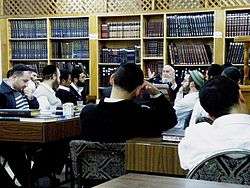Shiur (Torah)
Shiur (/ˈʃiːər/, Hebrew: שיעור [ʃiˈʔuʁ], pl. shiurim, שיעורים [ʃiʔuˈʁim] lit. "Lesson") is a lesson on any Torah topic, such as Gemara, Mishnah, halakha, Tanakh, etc.

History
The shiur has been a primary method of teaching since Mishnaic times. In a famous Talmudic passage, Rabbi Judah haNasi averred that he gained his sharp mind from watching Rabbi Meir deliver the shiur. However, since the lecture hall was so crowded, his seat was behind the lectern, so he only saw Rabbi Meir from the back. "Had I seen him from the front, how much greater would I have become!" he declared.[1]
Yeshiva learning
Traditionally, a shiur refers to the type of learning that takes place in yeshivot and kollelim, in which students hear an in-depth lecture on the sugya (Gemara topic) the yeshiva is studying at the time.
Typically, yeshiva students attend a daily shiur yomi (daily lecture) given by a maggid shiur (literally, "sayer of the shiur") and a weekly shiur klali (comprehensive lecture, which sums up the week's learning) given by the rosh yeshiva.[2]The rosh yeshiva usually also gives the top shiur on a daily basis. Before the shiur, a bibliography and a series of textual references are posted so that students may prepare for the lesson in advance. Students typically spend several hours preparing for the shiur yomi. After the shiur, students spend additional time reviewing and clarifying the lesson that they have just heard. These preparation and review periods take place in a special time period called a seder, in which students study the lesson individually and/or in chavrutot (study pairs).
Shiurim may also be offered in yeshiva on topics in mussar, Chumash, and hashkafah (Jewish philosophy), depending on the yeshiva and the learning level of its students.[3]
Class levels
A shiur is also the name given to the different class-levels in a yeshiva. For example, first-year students are said to be in "Shiur Aleph"; second-year students are in "Shiur Bet"; third-year students are in "Shiur Gimmel, etc. In kollelim, the higher shiurim accommodate more advanced levels of learning. See Yeshiva #Talmud study.
Public study sessions
Synagogue rabbis and noted rabbis in the community also give shiurim to their constituencies. In shuls, the shiur given between Mincha and Maariv is usually geared to baalebatim (working men). Noted rabbis give more in-depth shiurim to attendees on Shabbat or weekday evenings, usually in the local synagogue or beth midrash (study hall).[4][5]
Modern use
In modern parlance, the term "shiur" has been extended to include any kind of Torah lesson — including lectures to children, women, and baalebatim (non-scholarly audience), and taped lectures circulated via cassette tape, computer hookup, MP3 or MP4 connection, or call-in telephone lines. Though by definition, a shiur is a comprehensive, structured lesson, some kiruv organizations advertise "five-minute shiurim" to attract beginning listeners.[6]
References
- Eruvin 13b, cited in Falk, Rabbi Pesach Eliyahu (1998). Modesty: An adornment for life. Feldheim Publishers. p. 167. ISBN 0-87306-874-2.
- "Frequently Asked Questions". Yeshivat Har Etzion. 2010. Retrieved 15 February 2011.
- "Frequently Asked Questions". Derech HaTalmud. 2010. Archived from the original on 18 February 2013. Retrieved 15 February 2011.
- Wallach, Shalom Meir (January 2004). The Seraph of Brisk: Rabbi Yehoshua Leib Diskin. Tevunah Publishers. p. 623. ISBN 1-58330-708-7.
- Eleff, Zev (2008). Mentor of Generations: Reflections on Rabbi Joseph B. Soloveitchik. Ktav Publishing House. pp. 293–294. ISBN 978-1-60280-011-3.
- "The Chicago Community Kollel Five-Minute Hilchos Tefillah Shiur". Chicago Community Kollel. Retrieved 15 February 2011.

